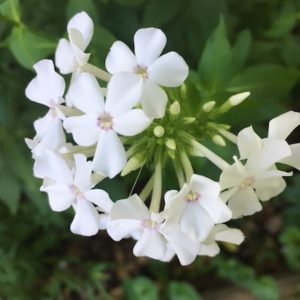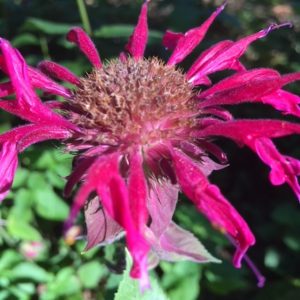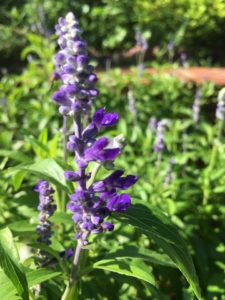 We just got back from a spectacular week in Oregon, visiting family. The weather was perfect and the grandchildren? What can I say? Absolutely adorable.
We just got back from a spectacular week in Oregon, visiting family. The weather was perfect and the grandchildren? What can I say? Absolutely adorable.
I was lucky enough to pick up Davey after his first day of kindergarten. He was all smiles and full of energy and wanted to DO something or MAKE something or just MOVE. When we got to his house, he went directly to the kitchen, climbed up on the counter and announced he was going to make a cake and he had his own recipe and didn’t need me. After I watched him pour both cayenne pepper and garlic powder into a bowl I decided maybe he did need me. I asked him if he had any blueberries and he answers, “millions!!!!”
And he was (almost) right. Their freezer was full of bags of frozen blueberries that he and his family had been picking all summer.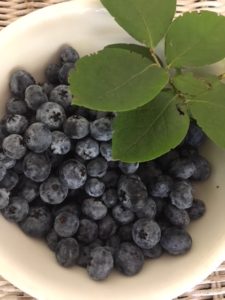
Hood River, Oregon is Mecca for the fruit enthusiast. Along the Columbia River and up into the hills and mountains on both the Oregon and the Washington side, there are acres and acres of orchards and farms. So much emphasis has been placed on growing berries throughout the state that Oregon has been referred to as “the Berry Basket” of the country.
Blueberries are one of our few native fruits. American Indians have been eating and enjoying them for centuries and were very aware of their health value. The first blueberries were cultivated in 1916. Today, blueberries are grown on five continents and production is about one billion pounds annually.
So what did Davey do with his “millions” of blueberries? He (with the help of his Mom) made the family favorite – blueberry brunch cake. You can use either frozen or fresh berries for this and it always turns out great and it’s not just for breakfast! You should try it yourself. The recipe is below. One word of advice – I’d leave out the cayenne pepper and the garlic powder!
Blueberry Brunch Cake
Cake:
- 1 cup flour
- 1/3 cup sugar
- 2 teaspoons baking powder
- 1 egg
- 1/3 cup light olive oil
- 1/2 cup milk
- 1 teaspoon lemon juice
- 1/2 teaspoon salt
Mix dry ingredients together. In a separate bowl, mix the olive oil, egg, milk and lemon juice. Mix in with the dry ingredients and pour into a greased square 8″ x 8″ pan.
Topping:
- 1 1/4 cups blueberries
- 1/3 cup sugar
- 1/2 teaspoon cinnamon
- 1/4 cup flour
- 2 tablespoons butter
Mix all topping ingredients and pour evenly over the cake batter.
Bake at 350 degrees until cake has set, about 30 minutes. Enjoy!

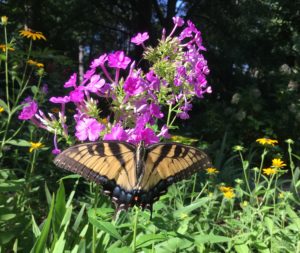 Yesterday I was cutting flowers to bring into the house when a butterfly landed on a stalk of phlox that I had just cut, almost as if to say “wait, wait, one more sip.”
Yesterday I was cutting flowers to bring into the house when a butterfly landed on a stalk of phlox that I had just cut, almost as if to say “wait, wait, one more sip.”
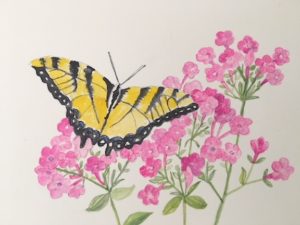 Females lay small green eggs singly on host plants such as tulip poplar, wild black cherry, ash, willow and sweet bay. The caterpillars are brown and white when young, turning green with black eyespots as they age. This species usually broods 2 – 3 times a year in our region, spending the cold winter months hibernating in the chrysalis stage.
Females lay small green eggs singly on host plants such as tulip poplar, wild black cherry, ash, willow and sweet bay. The caterpillars are brown and white when young, turning green with black eyespots as they age. This species usually broods 2 – 3 times a year in our region, spending the cold winter months hibernating in the chrysalis stage.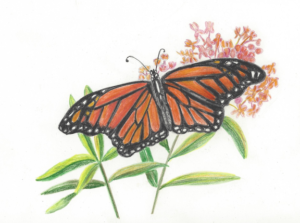
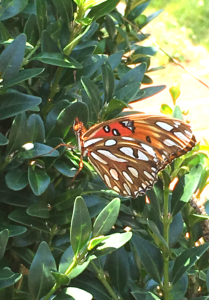
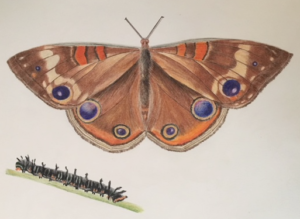



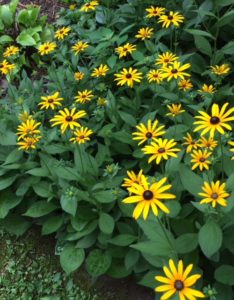
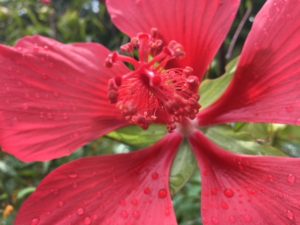
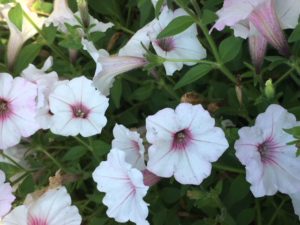 Steven Stills may have had it right. If you can’t be with the one you love, “love the one you’re with.” I think about that when I’m weeding the grass out of the petunias in the front garden. Frankly (don’t tell Petunia), I’ve never been a big fan of this flower. Oh yeah, yeah, I love all flowers etc. etc. but petunias? Big fat blobs on skinny stems? Petunias lack the scent of a tea rose, the complexity of an orchid, the beauty of a lily. However, since I can’t “be” with tea roses, orchids and lilies all summer, I’ve decided to love the one I’m with. And I’m with petunias.
Steven Stills may have had it right. If you can’t be with the one you love, “love the one you’re with.” I think about that when I’m weeding the grass out of the petunias in the front garden. Frankly (don’t tell Petunia), I’ve never been a big fan of this flower. Oh yeah, yeah, I love all flowers etc. etc. but petunias? Big fat blobs on skinny stems? Petunias lack the scent of a tea rose, the complexity of an orchid, the beauty of a lily. However, since I can’t “be” with tea roses, orchids and lilies all summer, I’ve decided to love the one I’m with. And I’m with petunias.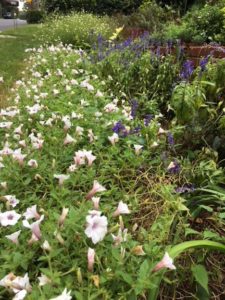

 Unfortunately, I only have a little bit of thyme, but I did want to offer some sage advice about growing herbs. What I mint to say was…..okay, I’ll stop. Puns are an integral (unfortunate?) part of family humor and I know that I’ll rue the day if I keep it up. Sort of like unleashing Rosemary‘s baby.
Unfortunately, I only have a little bit of thyme, but I did want to offer some sage advice about growing herbs. What I mint to say was…..okay, I’ll stop. Puns are an integral (unfortunate?) part of family humor and I know that I’ll rue the day if I keep it up. Sort of like unleashing Rosemary‘s baby. Rosemary is by far the biggest herb in my garden. Planted in the center of my front garden, it is huge and bushy and healthy. I’m so enamored with this evergreen shrub that I have planted several small ones along the front brick wall as an evergreen backdrop.
Rosemary is by far the biggest herb in my garden. Planted in the center of my front garden, it is huge and bushy and healthy. I’m so enamored with this evergreen shrub that I have planted several small ones along the front brick wall as an evergreen backdrop.


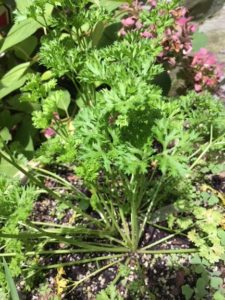
 Before you jump to any conclusions, let me say that my “trek” only lasted 7 miles (not the possible 2000 plus) and a few hours (not the 3 – 4 months it takes to do the whole thing.). BUT, being on the trail with only my dog for company was a blast. My favorite hiking partner, Jack, had to work so last Friday Sadie and I headed out to hike the trail, starting at Woody’s Gap in north Georgia.
Before you jump to any conclusions, let me say that my “trek” only lasted 7 miles (not the possible 2000 plus) and a few hours (not the 3 – 4 months it takes to do the whole thing.). BUT, being on the trail with only my dog for company was a blast. My favorite hiking partner, Jack, had to work so last Friday Sadie and I headed out to hike the trail, starting at Woody’s Gap in north Georgia.



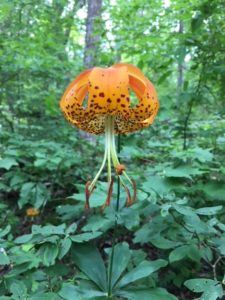
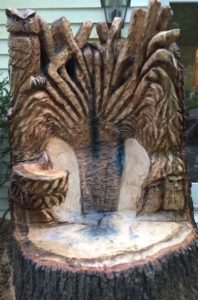 Several months ago, I wrote about the demise of trees in our neighborhood and how we have had three very large trees go down on our property. A huge oak, inches from the house, loomed large not only over the roof of our bedroom but also in my thoughts. We finally, sadly, had it taken down, which broke my heart but also made it easier to sleep at night.
Several months ago, I wrote about the demise of trees in our neighborhood and how we have had three very large trees go down on our property. A huge oak, inches from the house, loomed large not only over the roof of our bedroom but also in my thoughts. We finally, sadly, had it taken down, which broke my heart but also made it easier to sleep at night.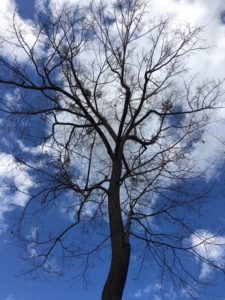 Jack and I decided to have a piece of art made from the remaining stump. Jack’s first suggestion was a life size carving of himself, which I laughingly and quickly vetoed. ( I think he was kidding). His next suggestion was to have a chair carved out of it which I thought was a brilliant idea. When we had the tree removed, we asked that they leave the stump 5 1/2 feet tall.
Jack and I decided to have a piece of art made from the remaining stump. Jack’s first suggestion was a life size carving of himself, which I laughingly and quickly vetoed. ( I think he was kidding). His next suggestion was to have a chair carved out of it which I thought was a brilliant idea. When we had the tree removed, we asked that they leave the stump 5 1/2 feet tall. 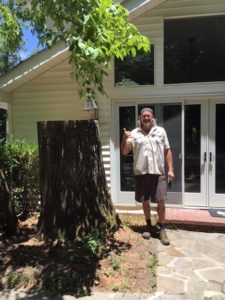 A quick online search provided the names of several chainsaw artists but only one was of real interest to me. I contacted him and Kary Kaley, Junior entered our lives.
A quick online search provided the names of several chainsaw artists but only one was of real interest to me. I contacted him and Kary Kaley, Junior entered our lives.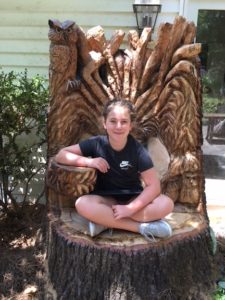 I had a pretty good idea of what I wanted from this stump and Kary did an outstanding job making my vision into a reality. Basically, I wanted it to feel like you were sitting in the tree when you sat on this chair. And I do! It is surprisingly comfortable and with the one, wide arm, you can happily sit there with a cup of coffee or a glass of wine, looking at the garden and feeling a part of it. Today I tried sitting in it with a grandchild and it’s plenty big enough. I envision sitting with a child, reading. Maybe A Tree Grows in Brooklyn? The Giving Tree? The Lorax?
I had a pretty good idea of what I wanted from this stump and Kary did an outstanding job making my vision into a reality. Basically, I wanted it to feel like you were sitting in the tree when you sat on this chair. And I do! It is surprisingly comfortable and with the one, wide arm, you can happily sit there with a cup of coffee or a glass of wine, looking at the garden and feeling a part of it. Today I tried sitting in it with a grandchild and it’s plenty big enough. I envision sitting with a child, reading. Maybe A Tree Grows in Brooklyn? The Giving Tree? The Lorax?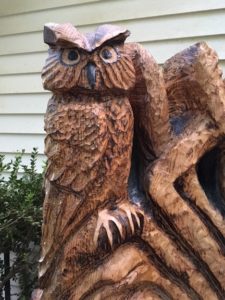
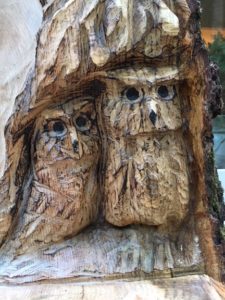
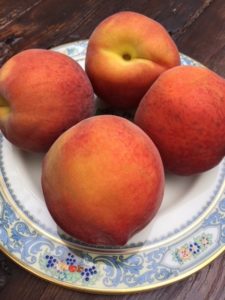 Everyone knows that Georgia is the Peach State. Logic would dictate that it is because Georgia produces so many peaches. Just like California, the Golden State, produces so much gold? or Louisiana produces so many pelicans?? or North Carolina produces so many Tar Heels????? (not counting sports fans). At this point I began to realize that logic has little to do with a state’s nickname, even in Georgia.
Everyone knows that Georgia is the Peach State. Logic would dictate that it is because Georgia produces so many peaches. Just like California, the Golden State, produces so much gold? or Louisiana produces so many pelicans?? or North Carolina produces so many Tar Heels????? (not counting sports fans). At this point I began to realize that logic has little to do with a state’s nickname, even in Georgia.

 Rivers, my (almost) 11 year old grandson is quite the baker and when the family got together last week, Rivers baked TWO gorgeous peach pies. He has his own website and cooking blog where he posted the recipe. So, check it out and let us know what you think:
Rivers, my (almost) 11 year old grandson is quite the baker and when the family got together last week, Rivers baked TWO gorgeous peach pies. He has his own website and cooking blog where he posted the recipe. So, check it out and let us know what you think: 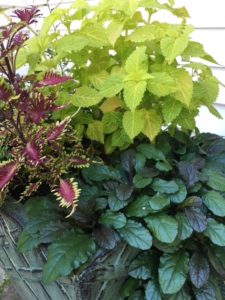 I love planter boxes! They offer the opportunity to garden in a box, to move or change an entire landscape on a whim. But, I have to admit that it takes time and money to replant all my containers twice a year – once in spring and again in the fall. So, I had the “brilliant” idea of planting perennials in containers and sitting back in the rocking chair to watch them grow and thrive year after year.
I love planter boxes! They offer the opportunity to garden in a box, to move or change an entire landscape on a whim. But, I have to admit that it takes time and money to replant all my containers twice a year – once in spring and again in the fall. So, I had the “brilliant” idea of planting perennials in containers and sitting back in the rocking chair to watch them grow and thrive year after year.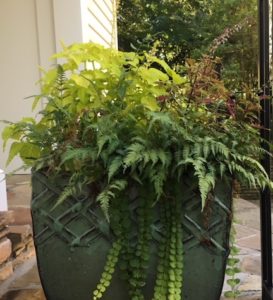
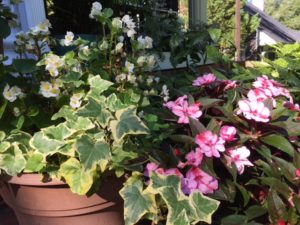
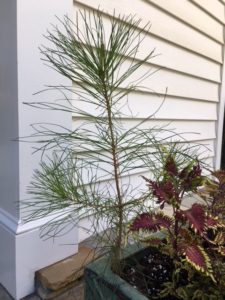
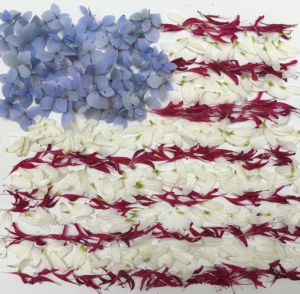 As people prepare to celebrate the Fourth of July, I see red, white and blue everywhere, including in my own backyard. I have to admit that I had to cheat a little with the colors, as my reds are a little pink and my blue is a little purple. But, for the most part, my garden boasts the color of old glory.
As people prepare to celebrate the Fourth of July, I see red, white and blue everywhere, including in my own backyard. I have to admit that I had to cheat a little with the colors, as my reds are a little pink and my blue is a little purple. But, for the most part, my garden boasts the color of old glory.